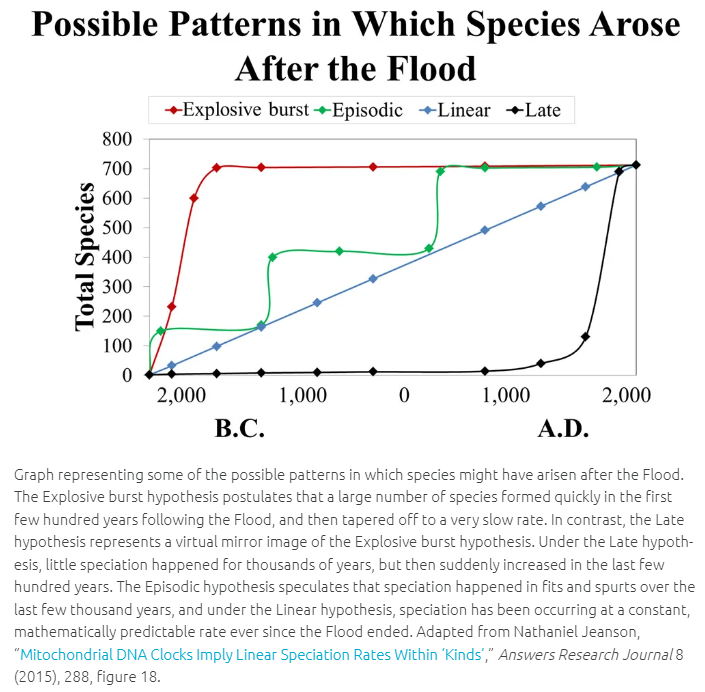Recent studies estimate that Noah would have taken several thousand animals, each averaging about the size of a small sheep, on board the Ark some 4,500 years ago.-1 Of the kinds (meaning those that could reproduce together) that stepped on the ark, most went extinct for various reasons, including massive destruction of the environment, food shortages, food competition, and the advent of the Ice Age. All these were plausibly results of the global flood catastrophe. In the end, it is estimated that about 70% of the kinds that went on the ark eventually went extinct.
Of the 30% that survived, we have witnessed rapid diversification (speciation), which meets the timeline expectations and the biblical worldview of Young Earth Creationism.-1
The bible does not prohibit speciation-1, genetic bottlenecking, or genetic drift– these factors drive variety within the population by hereditary function, not universal common ancestry evolutionary theory. God designed the variety for survival and specialization into the genetic code to ensure that life on our planet would flourish beyond the global flood judgment.
No macro-evolution anywhere to be found
We have never witnessed one kind (family level) transmutating into a novel (all new) kind. However, we have seen species emerging which specialize in challenging and everchanging environments.
It can be argued that the global flood provided the catalyst that drove rapid speciation-1 due to migrations and intense competition for food and territory resulted immediately in the aftermath of the cataclysm.
“…there are fewer than 1.8 million documented species of organisms in the world. Consider also that over 98 percent of those species are fish, invertebrates, and non-animals (like plants and bacteria). This means that there are fewer than 34,000 species of known, land-dependent vertebrates in the world today”.
Source: IUCN 2014. IUCN Red List of Threatened Species. Version 2014.2. . Downloaded on 9 November 2016. Bolds and italics are mine.

Three examples that indicate rapid expansion of new species:
The Deer kind: As purely linear examples- of which populations expand exponentially, still, there are 55 species in the deer family living today; based on genetics, a new deer species have formed about every 80 years.

The Cat kind: There are 37 species in the Cat family today; Therefore, about one new Cat species has arisen roughly every 120 years.

The Horse (Equidae) kind: About seven species of horse (and donkey) family species are alive today; again, based on genetics, one new equid species has arisen approximately every 640 years. (Horses and Donkeys can be hybrid into Zonkeys).

Family taxonomic levels declining while species are ever increasing
As final evidence that speciation by heredity and not universal common ancestry evolution is the cause for the diversity, we find that the taxonomic categorization of the family (above species) is only declining while steadily new highly specialized species (below family) are constantly increasing. This evidence falls within the inferences made based on a biblical worldview of an original creation in the beginning by God (by kind- roughly the same as the family categorization).
Genetic entropy?

Arguably, genetic mutations are accumulating in the genome of living organisms as a detriment and degradation–the opposite of what is expected by universal common ancestry evolution. While the fidelity of DNA replication is very high and avoids mutations by design, mutations are still accumulating in each new generation of humans at the rate of about 75-150 new mutations. This has resulted (outside suppressors of technology and medicines) in declining life spans and increasing diseases and cancers, especially rarer (new) ones-2. Collectively this phenomenon has been coined genetic entropy.
“With the increasing ability to control…diseases in developed countries, there has come the realization that genetic diseases are a major cause of disability, death, and human tragedy…Many thousands of different genetic disorders with defined clinical symptoms have been identified…genetic defects are the major known cause of pregnancy loss …(or) spontaneous miscarriages involve a chromosomally abnormal fetus.”
https://www.britannica.com/science/human-genetic-disease; bold and italics are mine
Sources:
1- https://answersingenesis.org/noahs-ark/tracing-the-fate-of-the-animals-that-survived-the-post-flood-extinction/
2- https://hspersunite.org.au/rare-genetic-conditions-on-the-rise/


